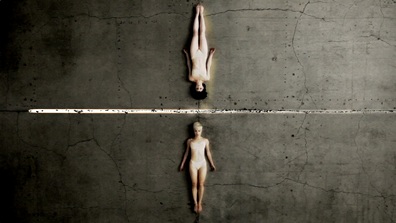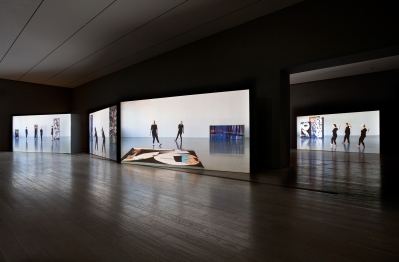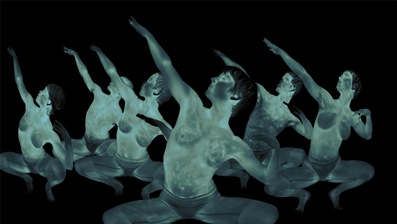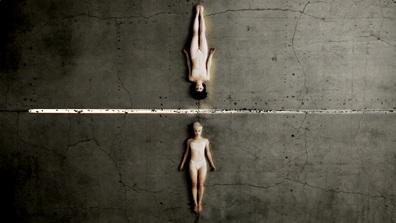Thursday and Friday in the Bing Theater, Dance Camera West will hold its 11th annual Dance Media Film Festival—featuring a variety of short films all about dance, from around the world. Currently on view in BCAM is the exhibition Sharon Lockhart | Noa Eshkol, which also takes dance as its subject. We asked Sarah Elgart, Director of Artistic Development at Dance Camera West, for her thoughts on the exhibition.

Still from RJ Muna's "Origami," screeing at LACMA On Thursday
In the exhibition Sharon Lockhart | Noa Eshkol, Los Angeles artist Sharon Lockhart engages in a kind of posthumous collaboration with the late Israeli dance composer Noa Eshkol. Eshkol developed the Eshkol-Wachman Movement Notation (EWNN) system with the architect Avraham Wachman. Although it’s unclear whether Eshkol ever performed her work—she was apparently unconcerned with critical acclaim—Eshkol was really also a choreographer who with her somewhat minimalist style and tone was reminiscent of Yvonne Rainer. She and Wachman developed their notation system using a combination of numbers and symbols to define the motion of any limb around its joint, a system that reportedly has the ability to describe “virtually every perceptible movement of the body.”

Installation view of "Sharon Lockhart | Noa Eshkol," 2012, Los Angeles County Museum of Art
Walking into the Broad Contemporary Art Museum, where the arrival of the giant elevator alone provides a kind of performance and spectacle, what is immediately notable is the use of scale, both architecturally and in the work that is housed therein. As such, Lockhart’s work is consistent with that notability. She works primarily with film and photography, using them to explore and gain insight into her subjects’ lives and work. In the first room however are Lockhart’s photographs, all hung vertically on the wall in contrast to Eshkol’s work, which is displayed in adjoining rooms horizontally. At first glance these photographs seem almost like drawings—apparent and seemingly scientifically accurate interpretations of Eshkol’s movement notation systems. These photographs are of beautiful spheres, each with different distinguished shapes within, and they are slightly reminiscent of cubism and/or what one might find in an instructional drawing book dealing with perspective. However, while perusing these, I was drawn forward by the ever audible, rhythmic background sound of a metronome, inviting me to see what lies in the next rooms. Here I was struck by the command of several large, rectangular structures, each one serving as a frontal projection screen for Eshkol’s dances. What is immediately notable and powerful is that the dancers, mostly middle aged and into their seventies, are just about life size, and standing almost within reach. Their faces are neutral, betraying no emotion, and in the space around the dancers are Eshkol’s tapestries, which appear almost like abstract paintings. The tapestries, seen in the final rooms of the show, are beautiful, abstract wall carpets, stitched together with recycled bits of fabric, drawing, symbols, and writings. The dances themselves are shot with static cameras, and succeed as straightforward and honest, un-manipulated documentation. This honesty, and the deliberate choice of dancers who were neither svelte nor very young, makes Eshkol’s dance works remarkably refreshing in their simplicity; and in concert with Lockhart’s use of scale, they have a subtle impact.

Still from Philippe Baylaucq's "Ora," screening at LACMA on Friday
With its patterned and mostly symmetrical choreography, Eshkol’s work is reminiscent in parts to the minimalist movement patterns used in the remarkable 3D thermal imaging film Ora by Philippe Baylaucq, which will appear in Dance Camera West’s upcoming Dance Media Film Festival at LACMA. Baylaucq innovatively uses heat emanating from the dancers’ bodies as the film’s sole light source, and as in Lockhart’s videos, the stark contrast of the dancers against a muted backdrop, coupled with unhurried, uniform choreography, draws attention to the negative space between the moving figures. Sharon Lockhart | Noa Eshkol also brings to mind RJ Muna’s Origami, another film featured in the festival, that highlights the pattern and symmetry often created by minimalist movement.
Sarah Elgart, Director of Artistic Development, Dance Camera West



